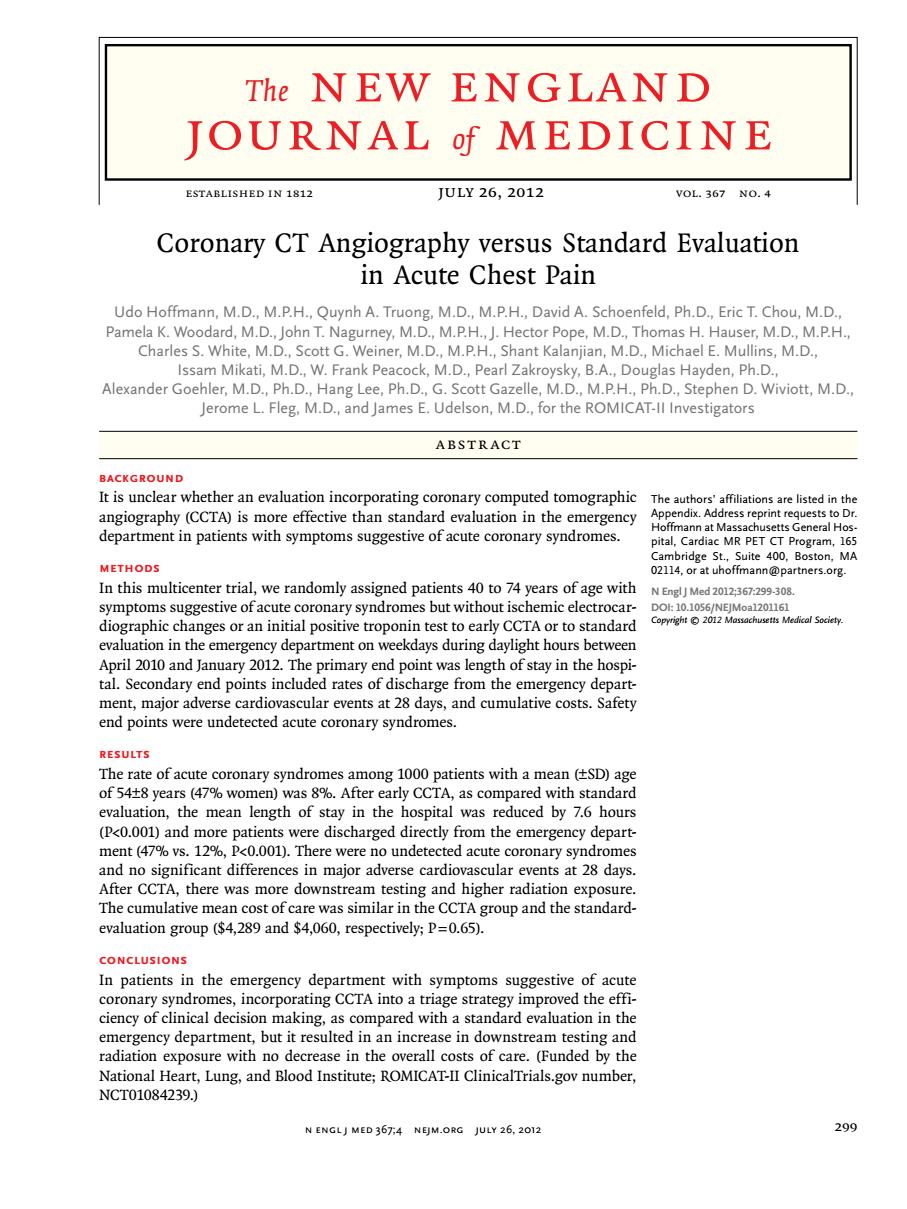正在加载图片...

The neW eNGLAND JOURNAL of MEDICINE ESTABLISHED IN 1812 JULY26,2012 voL367N0.4 Coronary CT Angiography versus Standard Evaluation in Acute Chest Pain la k Wo MD T er.M.D.M.P.H Charles S.White.M.D.Scott G.Weiner.M.D.M.P.H.Shant Kalanjian.M.D.Michael E.Mullins,M.D. Issam Mikati,M.D.W.Frank Peacock,M.D.Pearl Zakroysky,B.ADouglas Hayden,Ph.D. .D.,Stephen D.Wiviott,M.D.. ABSTRACT It is unclear whether an evaluation incorporating coronary computed tomographic The auth 2 sted in th angiography (CCTA)is more effective than standard evaluation in the emergency ess reprin department in patients with symptoms suggestive of acute coronary syndromes. al.Cardiac MR PET CT Program.169 METHODS n this multicenter trial,we randomly assigned patients 40 to 74 years of age with N EnglJ Med2012367:299-308 a April 2010 and January 2012.The primary end point was length of stay in the hospi tal.Secondary end points included rates of disch harge from the emergency depart- cardi as cular events at 28 days,and cumulative costs.Safety acute coronary syndromes. evaluation,the mean length of stay in the hospital was reduced by 7.6 hours (001)and more patients were discharged directly from the emergency depart ment (47%vs.12%, erences snmajor adverse card The cumulative mean cost of care was similar in the CCTA group and the standard- evaluation group ($4,8 and$060,respectively;P=0.65). CONCLUSIONS In patients in the emergency department with symptoms suggestive of acute d the eff coronary syndromes,noringCAsategy mpro ciency of clin making, compare de National Heart.Lung.and Blood Institute:ROMICAT-I.gov number. NCT01084239) N ENGLJ MED 367:4 NJM.ORG JULY 26,2012 299n engl j med 367;4 nejm.org july 26, 2012 299 The new england journal of medicine established in 1812 july 26, 2012 vol. 367 no. 4 Coronary CT Angiography versus Standard Evaluation in Acute Chest Pain Udo Hoffmann, M.D., M.P.H., Quynh A. Truong, M.D., M.P.H., David A. Schoenfeld, Ph.D., Eric T. Chou, M.D., Pamela K. Woodard, M.D., John T. Nagurney, M.D., M.P.H., J. Hector Pope, M.D., Thomas H. Hauser, M.D., M.P.H., Charles S. White, M.D., Scott G. Weiner, M.D., M.P.H., Shant Kalanjian, M.D., Michael E. Mullins, M.D., Issam Mikati, M.D., W. Frank Peacock, M.D., Pearl Zakroysky, B.A., Douglas Hayden, Ph.D., Alexander Goehler, M.D., Ph.D., Hang Lee, Ph.D., G. Scott Gazelle, M.D., M.P.H., Ph.D., Stephen D. Wiviott, M.D., Jerome L. Fleg, M.D., and James E. Udelson, M.D., for the ROMICAT-II Investigators A BS TR AC T The authors’ affiliations are listed in the Appendix. Address reprint requests to Dr. Hoffmann at Massachusetts General Hospital, Cardiac MR PET CT Program, 165 Cambridge St., Suite 400, Boston, MA 02114, or at uhoffmann@partners.org. N Engl J Med 2012;367:299-308. DOI: 10.1056/NEJMoa1201161 Copyright © 2012 Massachusetts Medical Society. Background It is unclear whether an evaluation incorporating coronary computed tomographic angiography (CCTA) is more effective than standard evaluation in the emergency department in patients with symptoms suggestive of acute coronary syndromes. Methods In this multicenter trial, we randomly assigned patients 40 to 74 years of age with symptoms suggestive of acute coronary syndromes but without ischemic electrocardiographic changes or an initial positive troponin test to early CCTA or to standard evaluation in the emergency department on weekdays during daylight hours between April 2010 and January 2012. The primary end point was length of stay in the hospital. Secondary end points included rates of discharge from the emergency department, major adverse cardiovascular events at 28 days, and cumulative costs. Safety end points were undetected acute coronary syndromes. Results The rate of acute coronary syndromes among 1000 patients with a mean (±SD) age of 54±8 years (47% women) was 8%. After early CCTA, as compared with standard evaluation, the mean length of stay in the hospital was reduced by 7.6 hours (P<0.001) and more patients were discharged directly from the emergency department (47% vs. 12%, P<0.001). There were no undetected acute coronary syndromes and no significant differences in major adverse cardiovascular events at 28 days. After CCTA, there was more downstream testing and higher radiation exposure. The cumulative mean cost of care was similar in the CCTA group and the standardevaluation group ($4,289 and $4,060, respectively; P=0.65). Conclusions In patients in the emergency department with symptoms suggestive of acute coronary syndromes, incorporating CCTA into a triage strategy improved the efficiency of clinical decision making, as compared with a standard evaluation in the emergency department, but it resulted in an increase in downstream testing and radiation exposure with no decrease in the overall costs of care. (Funded by the National Heart, Lung, and Blood Institute; ROMICAT-II ClinicalTrials.gov number, NCT01084239.)